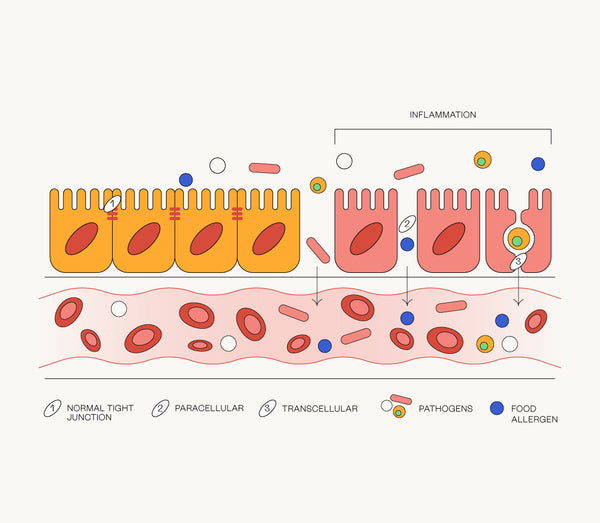What’s the deal with the gut-brain axis?
Your gut and brain are BFFs. With their own communication pathway, they send messages to each other. It’s like a Whatsapp group between your gut and your brain.
It’s called the gut-brain axis, and it’s pretty special.
In this three part series, we’ll explore the gut-brain axis, what it does, how it influences your brain health, and how you can keep it fit and strong.
So, sit tight as we take you on a journey from your brain to your gut and back again.
What is the gut microbiome?
First, let’s recap the amazing tiny ecosystem residing in your gastrointestinal tract.
Living in your gut are trillions of microorganisms including bacteria, viruses, and archaea. These microbes live in harmony with you in a mutually beneficial relationship.
Both you (the host) and these micro-buddies have a lot to gain. You provide a secure home and regular nourishment to your gut microbes and, in return, they transform fibre into useful metabolites like short-chain fatty acids (SCFAs).
The human body is ill-equipped to digest fibre, so these micro-organisms live within you to give you a helping hand. SCFAs have numerous health benefits within the human body, like strengthening the gut barrier to stop unwanted pathogens, toxins and partially digested food from entering the bloodstream and eliciting an immune response. Some also have anti-cancer properties and others protect the body from inflammation [1].
If you want to know more about this micro-ecosystem, then check out our Gut Microbiome 101 page [LINK].
What is the gut-brain axis?
The gut-brain axis is a bi-directional or two-way communication pathway between the central nervous system and the enteric nervous system (the one in your gut).
Exposure to the mother’s vaginal microbiome at birth, means the early inhabitants of the newborn gut microbiome can support the growth and development of the central and enteric nervous systems in the first few weeks of life [2]. This is the very beginning of the gut-brain axis.
Let’s take a look at how the gut and brain are connected.
Let’s get physical!
Physically, the gut and brain are linked by the longest of the 12 cranial nerves, the vagus nerve. It is the main component of the parasympathetic nervous system and responsible for important functions, including heart rate, mood, and digestion [3].
The vagus nerve reaches all the main organs in the human body including the stomach via numerous nerve branches. These branches have connecting points called neurons.
There are billions of neurons, also known as nerve cells, in the human body, distributed throughout the brain and central nervous system. Neurons are responsible for sending and receiving messages between your brain and other organs.
The vagus nerve helps to connect the 500 million neurons in the gut to the brain. These neurons send feedback from the gut environment to the brain, influencing brain health.
Similarly, the brain sends signals from the limbic system, the area associated with behavioural and emotional responses, to the gut [4]. That’s why you might experience butterflies in your stomach when you’re in an anxious situation.
Now we have a better understanding of why the vagus nerve is such an important component of the gut-brain axis!
The chemical connection
Alongside the physical connection between the gut and the brain, there’s a chemical one, too. It’s a bit like connecting your phone to wifi, except it’s powered by neurotransmitters. These are chemicals produced by the brain that are responsible for regulating your emotions and feelings.
You’re probably already familiar with some of the neurotransmitters that are important in this bidirectional communication hub, like:
- dopamine
- epinephrine
- norepinephrine
- serotonin [5].
However, it’s not just your brain that’s responsible for producing these chemical messengers, your gut is too.
For example, serotonin is often associated with mood and happiness and has an impact throughout the entire body. It is involved in sleep, appetite and, yes of course, digestion.
It’s so intrinsically linked with the gut in fact, that over 90% of the serotonin in the body is made in the colon [6]. Gut microbes make another important neurotransmitter called gamma-aminobutyric acid, GABA for short [7].
Research shows that there is a link between altered GABA neurotransmission and the development of central nervous system disorders like those affecting pain, sleep, and behaviour [5].
The neurotransmitters produced by the gut and brain are responsible for transmitting messages between the two organs. Ultimately, influencing the activity or function of the other. So, what’s going on in your gut can influence your mood and appetite, for example.
Conclusion
And that’s the introduction to the gut-brain axis complete. Hopefully now you have a better understanding of the gut microbiome, what the gut-brain axis is and are starting to see that it has an important role in human health.
Next time, we’re going to hone in on how the gut-brain axis influences brain health. Stay tuned!
Sources
[1] Silva, Y, P., Bernardi, A & Frozza, R, L. The role of short-chain fatty acids from the gut microbiota in gut-brain communication. Front. Endocrinol. https://doi.org/10.3389/fendo.2020.00025(2020)
[2] Mueller, N, T et al. (2015). The Infant Microbiome Development: Mom Matters. Trends Mol Med 21.doi: 10.1016/j.molmed.2014.12.002 (2015)
[3] Breit, S., Kupferberg, A., Rogler, G and Hasler, G. Vagus nerve as modulator of the brain-gut axis in psychiatric and inflammatory disorders. Front. Psychiatry. https://doi.org/10.3389/fpsyt.2018.00044 (2018)
[4] Rajmohan, V & Mohandas, E. The Limbic System. Indian J Psychiatry 49. doi: 10.4103/0019-5545.33264 (2007)
[5] Mittal, R et al. Neurotransmitters: The critical modulators regulating gut-brain axis. J Cell Physiol 232. doi: 10.1002/jcp.25518 (2017)
[6] Yano, J, M et al. Indigineous bacteria from the gut microbiota regulate host serotonin biosynthesis. Cell 161. doi: 10.1016/j.cell.2015.02.047 (2015)
[7] Strandwitz, P. Neurotransmitter modulation by the gut microbiota. Brain Res 1693. doi: 10.1016/j.brainres.2018.03.015 (2018)


